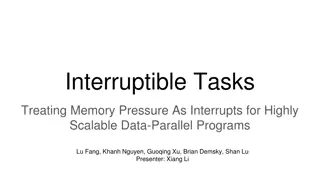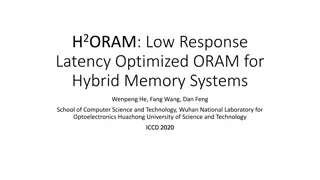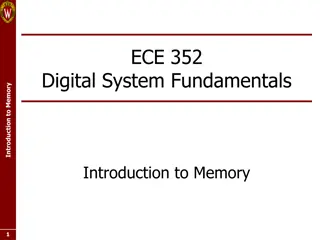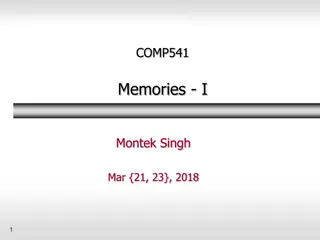
Memory Systems: Heuristics, Allocation, and Fragmentation
Explore the intricacies of memory systems, including heuristics for allocation, memory fragmentation, and managing free frames. Learn about different algorithms for allocating memory and handling internal and external fragmentation in this insightful chapter by Smruti R. Sarangi from IIT Delhi.
Download Presentation

Please find below an Image/Link to download the presentation.
The content on the website is provided AS IS for your information and personal use only. It may not be sold, licensed, or shared on other websites without obtaining consent from the author. If you encounter any issues during the download, it is possible that the publisher has removed the file from their server.
You are allowed to download the files provided on this website for personal or commercial use, subject to the condition that they are used lawfully. All files are the property of their respective owners.
The content on the website is provided AS IS for your information and personal use only. It may not be sold, licensed, or shared on other websites without obtaining consent from the author.
E N D
Presentation Transcript
Chapter 6: Memory Systems Smruti R Sarangi IIT Delhi (c) Smruti R. Sarangi, 2023 1
Outline of this Chapter Kernel Memory Allocation Page Management Virtual and Physical Address Spaces Traditional Heuristics (c) Smruti R. Sarangi, 2023 2
Heuristics for memory allocation: no virtual memory (c) Smruti R. Sarangi, 2023 3
Simple Memory Allocation Consider the era that did not have virtual memory OR systems that don t have virtual memory OR the parts of the kernel that need to use physical memory Memory Hole Limit Allocated region Base (c) Smruti R. Sarangi, 2023 4
Fragmentation Space wastage Internal Fragmentation Space wasted within an allocated region. Let us say that we waste the last 4 KB in a region. External Fragmentation Holes between regions. (c) Smruti R. Sarangi, 2023 5
Algorithms to Allocate Space Let s say that there is a request for a memory region R Memory Which hole do we fill? Several Solutions (c) Smruti R. Sarangi, 2023 6
Algorithms to Allocate Space II Choose the smallest hole that is just about larger than R. Best Fit Worst Fit Choose the largest hole. Start searching from the last allocation that was made and move towards higher addresses (with wraparounds). Next Fit First Fit Choose the first available hole (c) Smruti R. Sarangi, 2023 7
Heuristics for memory allocation: with virtual memory (c) Smruti R. Sarangi, 2023 8
What about allocating free frames? We can only have internal fragmentation with virtual memory Use a bitmap or an Emde Boas tree to manage the list of free frames The main issue here is page replacement If the main memory is full, which frame in memory should be sent to the swap space? (c) Smruti R. Sarangi, 2023 9
General Stack-based Algorithms The notion of the stack distance Hypothetically 1. Maintain a stack of all pages 2. Whenever there is a page access, locate the entry in the stack. 3. Record the distance from the top of the stack the stack distance. 4. Bring it to the top. (c) Smruti R. Sarangi, 2023 10
A heavy tailed curve. Matches a log-normal distribution (most of the time) Typical Stack Distance Plot 0.3 0.25 Representative plot 0.2 Probability 0.15 0.1 0.05 0 0 1 2 3 4 5 6 7 8 Stack distance (c) Smruti R. Sarangi, 2023 11
Significance of the Stack Distance It is a measure of temporal locality Higher is the stack distance, lower is the temporal locality and vice versa The log-normal curve implies the following: There are very few accesses with ultra-small stack distances There is a distinct peak and a long tail Easy to interpret theoretical tool Practical algorithms are hard to realize (c) Smruti R. Sarangi, 2023 12
Optimal Algorithm Cost of a page replacement algorithm = Number of page faults Hypothetical Optimal Algorithm 1. Order all the pages in increasing order of next use time. Assume you can predict the future. 2. Replace the page that will be accessed the last. Use the same contradiction-based technique to prove optimality. This is a stack-based algorithm. The replacement is done based on the stack distance. (c) Smruti R. Sarangi, 2023 13
The LRU (Least Recently Used) Algorithm Impractical !!! Tag each page (in the memory) with the last time that it was accessed. Augment each entry in the page table with a timestamp. Choose the page whose last access time is the earliest Let us assume that the past is a good predictor of the future. These algorithms come with many theoretical guarantees Every memory access cannot increment a counter. The overheads are prohibitive. (c) Smruti R. Sarangi, 2023 14
Such Stack-based Algorithms can be made Practical Order all the physical pages (frames) in memory in some order (maybe FIFO order) Leverage their protection bits. Mark them no access . Access bit = 0 When we access a page with its access bit set to 0, there is a fault Set it to 1 Periodically, set all access bits to 0 OR, alternatively record the time that it was set from 0 1. Reset it to 0 only if a certain duration has been exceeded. (c) Smruti R. Sarangi, 2023 15
WS_Clock Page Replacement Algorithm Access bit = 1 Access bit = 0 A pointer (like the minute hand of a clock) points to a physical page If its (access bit = 1) set it to 0 Otherwise, replace it Next time, start the pointer from the same point and wraparound at the end (c) Smruti R. Sarangi, 2023 16
WS_Clock based Second Chance Algorithm Access bit = 1 Access bit = 0 <Access bit, Modified bit> New state Action <0, 0> <0, 0> Go ahead and replace <0, 1> <1, 0> <0, 0> <0, 0> Schedule a write-back Move forward <1, 1> <1, 0> Frequently used frame; move forward. Schedule a write-back. (c) Smruti R. Sarangi, 2023 17
FIFO and the Beladys Anomaly [1] Consider the FIFO page replacement algorithm 10 faults Access sequence 1 2 3 4 1 2 5 1 2 3 4 5 2 1 5 4 4 3 2 1 5 4 3 2 1 4 3 2 1 5 4 3 2 1 5 4 3 2 1 3 2 1 5 4 3 2 1 4 3 2 1 3 2 1 4 frames (c) Smruti R. Sarangi, 2023 18
FIFO and the Beladys Anomaly 9 faults Consider the FIFO page replacement algorithm Access sequence 1 2 3 4 1 2 5 1 2 3 4 5 5 2 1 4 3 5 4 3 5 1 4 3 2 5 2 1 5 2 1 2 1 3 5 2 1 4 3 2 1 4 3 2 1 3 frames (c) Smruti R. Sarangi, 2023 19
Final Word on Page Replacement Stack-based algorithms are by and large impractical We need to create approximations. FIFO and Random replacement algorithms may exhibit the Belady s anomaly The ratio between the faults in a large memory and small memory is unbounded can be as large as we want it to be [2]. The clock-based algorithms approximate LRU and are known to work well. (c) Smruti R. Sarangi, 2023 20
Working Sets Assume you have a recency-based replacement algorithm A working set is a set of pages that a program access over a short duration. Page fault rate Working set size How short is short? Keep track of the working set and ensure that it is in memory #pages in memory (c) Smruti R. Sarangi, 2023 21
Thrashing Consider a system with a lot of processes and a paucity of memory If the space allocated to a process is less than its working set The process will spend most of its time fetching its working set The performance counters will indicate low CPU utilization The kernel will see the low load average and add more processes to the CPU s run queue This will make the problem even worse Ultimately the system will crash This is called thrashing. (c) Smruti R. Sarangi, 2023 22
Outline of this Chapter Kernel Memory Allocation Page Management Virtual and Physical Address Spaces Traditional Heuristics (c) Smruti R. Sarangi, 2023 23
Virtual Memory Map Documentation/x86/x86_64/mm.rst 512 MB + 1520 MB Kernel code + modules Per-CPU area 0.5 TB The memory map is not drawn to scale and many regions have not been shown. There are holes between regions. If any of the holes are written to, it is a fault. The direct-mapped zone can be used to access the physical memory directly (albeit by subtracting an offset) The kernel text (code) starts at physical address 0 Memory-mapped I/O 12.5 PB Direct mapped region 32 PB Holes 64 PB User space (c) Smruti R. Sarangi, 2023 24
Let us start from mm_struct struct mm_struct { . pgd_t *pgd; }; Pointer to the page table. The CR3 register is set to this value. Type: u64 PMD 22-30 PTE 13-21 Page 1-12 PGD 57-49 PUD 31-39 P4D 40-48 CR3 register points to the PGD of the current process (c) Smruti R. Sarangi, 2023 25
Explanation /arch/x86/include/asm/pgtable_types.h Acronym Full Form PGD Page Global Directory 57-bit virtual address P4D Fourth level page table 5-Level Page Tables PUD Page Upper Directory 128 PB VA space PMD Page Middle Directory PTE Page Table Entry Acronym Full Form PROT_READ Read permission /include/uapi/asm- generic/mman-common.h PROT_WRITE Write permission The variable pgprot_t contains the protection bits PROT_EXEC Execute permission PROT_SEM Can be used for atomic ops PROT_NONE Page cannot be accessed (c) Smruti R. Sarangi, 2023 26
The follow_pte function /mm/memory.c Key function used to traverse the page table int follow_pte(struct mm_struct *mm, unsigned long address, pte_t **ptepp, spinlock_t **ptlp) { pgd_t *pgd; p4d_t *p4d; pud_t *pud; pmd_t *pmd; pte_t *ptep; This code does not show the cases where an entry does not exist. pgd = pgd_offset(mm, address); p4d = p4d_offset(pgd, address); pud = pud_offset(p4d, address); pmd = pmd_offset(pud, address); ptep = pte_offset_map_lock(mm, pmd, address, ptlp); Walk the page table *ptepp = ptep; return 0; } Set the return value. Keep the page locked. (c) Smruti R. Sarangi, 2023 27
Accessing any given level (lets say PMD) // /include/linux/pgtable.h pmd_t *pmd_offset(pud_t *pud, unsigned long address) { return pud_pgtable(*pud) + pmd_index(address); } unsigned long pmd_index(unsigned long address) { return (address >> PMD_SHIFT) & (PTRS_PER_PMD - 1); } /* arch/x86/include/asm/pgtable.h */ pmd_t *pud_pgtable(pud_t pud) { return (pmd_t *)__va(pud_val(pud) & pud_pfn_mask(pud)); } /* arch/x86/include/asm/page.h */ #define __va(x) ((void *)((unsigned long)(x)+PAGE_OFFSET)) Starting address of the kernel region (c) Smruti R. Sarangi, 2023 28
/include/linux/mm_types.h Structure of a PTE entry Protection bits Frame number (52 bits, maximum) Some other important data structures that are a part of the memory subsystem page Data structure for every physical page (frame) in main memory. The aim is to record (to some extent) who is using the page and what for. folio Represents a contiguous set of bytes (physically and virtually). Its size is a power of two and is the page size. (c) Smruti R. Sarangi, 2023 29
/include/linux/mm_types.h struct page flags One large union (20/40 bytes): it can store a bunch of things. Choices: Pointer to the address space (I/O device whose pages are mapped) Pointer to a pool of pages Page map (mapped from a dedicated device or DMA pages) Reference count This is a classic example of a data structure that has a very flexible structure: it can store anything (depending upon the end user). (c) Smruti R. Sarangi, 2023 30
https://lwn.net/Articles/893512/ struct folio https://lwn.net/Articles/849538/ Definition: A compound page is an aggregate of two or more contiguous pages A folio primarily points to a compound page. It is primarily needed to manage millions of pages in large memories It points to the first page in a compound page It is very useful for memory mapped I/O (I/O devices and files) It is naturally aligned towards read prefetching and sequential writes Writes and modification bits can be maintained at the folio level Easier to maintain LRU-based replacement lists (c) Smruti R. Sarangi, 2023 31
Folio of pages A folio acts like a single page It has its permission bits and copy-on-write state Whenever a page needs to be migrated, swapped out, or replicated (because COW) If a page is a part of a folio, then the entire operation happens on the folio Notion of huge pages We can have pages with size 2 MB and 1 GB Some server processors support huge pages. This requires changes to addressing or multiple entries are created in the TLB (one for each page). The latter solution is very expensive. Naturally align with folios. (c) Smruti R. Sarangi, 2023 32
pte pfn page #define pte_pfn(x) phys_to_pfn(x.pte) #define phys_to_pfn(p) ((p) >> PAGE_SHIFT) #define __pfn_to_page(pfn) \ ({ unsigned long __pfn = (pfn); \ struct mem_section *__sec = __pfn_to_section(__pfn); \ __section_mem_map_addr(__sec) + __pfn; \ }) The contents of the pte (page table entry) contain the physical frame number and other protection information pfn is just the physical page number that is obtained by shifting the pte by PAGE_SHIFT (=12) struct page corresponds to a physical frame. Physical pages are organized into different sections. Each section points to a memory map (an array of page structures). (c) Smruti R. Sarangi, 2023 33
TLB (c) Smruti R. Sarangi, 2023 34
/arch/x86/mm/tlb.c TLB It is important to manage the TLB well. More than 99% of the requests are satisfied by the TLB. A TLB miss is quite expensive. It involves a costly page table walk. In x86 machines By default, it is a 4 to 16-way set associative cache Some processors allow the user to configure the associativity Some processors can also have a 2-level TLB or a separate data TLB and i-TLB Each entry of the TLB (corresponding to a virtual page number) contains a pointer to a physical page number, and has other protection bits (+ other data) Flushing the TLB Just modifying the CR3 register flushes the TLB Some entries can still be retained (not flushed) if the G (global) bit is set The invlpg instruction can flush the entire TLB, or a specific page, or the pages belong to a process. How ??? (c) Smruti R. Sarangi, 2023 35
Notion of the ASID (PCID) A context switch is heavy on the TLB The new process suffers from plenty of TLB misses The same is true when the old process runs on the core again If we can store the pid along with every TLB entry, our job is done Then two processes can run on the same core (one after the other) without flushing the TLB. Let us call this additional annotate the ASID (address space ID), Intel calls it PCID Processor-Context ID Problem: A pid is an OS-specific concept, whereas the ASIC/PCID is a hardware concept. How to reconcile both? (c) Smruti R. Sarangi, 2023 36
Let the Hardware Win Maintain a small per-CPU array of PCIDs Cache the last few mm (memory maps) for tasks that executed on the CPU The PCID bits are set to [1, TLB_NR_DYN_ASIDS] TLB_NR_DYN_ASIDS = 6 [default value] (/include/asm/tlbflush.h) The PCID is the first 12 bits of the CR3 register Each TLB entry also contains the associated PCID It is matched with the current PCID The INVPCID instruction can be used to invalidate all the TLB entries that corresponds to a single PCID (c) Smruti R. Sarangi, 2023 37
https://notes.shichao.io/utlk/ch2/ Lazy TLB Mode Assume several CPUs share a page table One of them runs a call that invalidates an entry This is invalidated for the full process All the TLBs need to be flushed Let s say that one of the CPUs is running a kernel thread It need not invalidate the entry immediately It can set the CPU to lazy TLB mode Note: The kernel threads don t have separate page tables. It is a common one that is appended with user mode page tables (one large user + kernel page table) (c) Smruti R. Sarangi, 2023 38
Lazy TLB Mode Three cases 1. The kernel tries to access the invalidated page. This will happen only via fixed entry points. This cannot happen in an uncoordinated fashion. Appropriate checks can be carried out and exceptions can be thrown. 2. The kernel switches to another user process. In this case, all the TLB entries of the original process are flushed out. 3. The kernel switches back to the same user process. Just finish the work of invalidating all the entries that were deferred. (c) Smruti R. Sarangi, 2023 39
Partitioning Physical Memory (c) Smruti R. Sarangi, 2023 40
NUMA Machine Node Shared interconnect CPUs have some amount of local memory, which is much faster They are also organized into clusters. A CPU can access all memory: intra-cluster and inter-cluster Accesses to intra-cluster memory is much faster. This is a non-uniform memory access machine (NUMA machine) Each cluster is known as a node (c) Smruti R. Sarangi, 2023 41
Is all physical memory in a node the same? https://lwn.net/Articles/789304/ 1. Partition the physical memory space (in a node) into zones 2. Treat the frames (physical pages) in each zone differently. 3. The zones may themselves be stored on different devices. 4. I/O Devices may need a dedicated region (assign a zone) Zone one-to-one PFN struct page There is a mem_map for each section that stores this mapping mem_section sections (c) Smruti R. Sarangi, 2023 42
Physical Memory Zones in Linux /include/linux/mmzone.h enum zone_type { ZONE_DMA, ZONE_NORMAL, #ifdef CONFIG_HIGHMEM ZONE_HIGHMEM, #endif ZONE_MOVABLE, #ifdef CONFIG_ZONE_DEVICE ZONE_DEVICE, #endif __MAX_NR_ZONES }; Physical pages that are accessible only by the DMA controller Normal frames Useful in systems where the physical memory exceeds the size of max virtual memory. It is assumed that the corresponding memory device may be removed at any point of time and possibly re-inserted later. These frames are stored in novel memory devices like NVM devices. (c) Smruti R. Sarangi, 2023 43
/include/linux/mmzone.h struct zone struct zone { int node; Pointer to the pglist_data structure: details of the NUMA node struct pglist_data *zone_pgdat; unsigned long zone_start_pfn; zone_end_pfn = zone_start_pfn + spanned_pages- 1 atomic_long_t managed_pages; unsigned long spanned_pages; unsigned long present_pages; Name of the zone const char *name; Free areas in a zone (physical memory) struct free_area free_area[MAX_ORDER]; } (c) Smruti R. Sarangi, 2023 44
/include/linux/mmzone.h Data Structure to Manage the Memory in a Zone Ordering of zones typedef struct pglist_data { struct zone node_zones[MAX_NR_ZONES]; struct zonelist node_zonelists[MAX_ZONELISTS]; int nr_zones; Zones organized hierarchically unsigned long node_present_pages; unsigned long node_spanned_pages; int node_id; Number of pages owned by NUMA node_id Page swapping daemon struct task_struct *kswapd; struct lruvec __lruvec; } pg_data_t; Maintains LRU state information (c) Smruti R. Sarangi, 2023 45
Outline of this Chapter Kernel Memory Allocation Page Management Virtual and Physical Address Spaces Traditional Heuristics (c) Smruti R. Sarangi, 2023 46
Required Background Bloom Filters PI Controller Reverse Maps (c) Smruti R. Sarangi, 2023 47
Background: Bloom Filter Inserting a Key in a Bloom Filter A data structure that answers if an element is a member of a set (probabilistically) Map a key to k different bit positions using k hash functions Key Hash function Set to 1 H1 H3 H4 H2 1 1 1 1 Array of m bits Initially all the bits are 0 (c) Smruti R. Sarangi, 2023 48
Background: Bloom Filter Checking for Set Membership in a Bloom Filter 1. Given a key compute the k different hash values (bit positions) 2. Check that each bit position stores a 1. If at least one bit position stores a 0, then the key is not present. Elements cannot be deleted unless we store a count at each bit position We need to periodically reset the Bloom Filter 3. 4. False positives are allowed No false negatives (c) Smruti R. Sarangi, 2023 49
Background: PI controller The PI Controller P ??(?) ?(?) I SP ? ? ?(?)?? System pv(t) Term Meaning Explanation in this context P term Proportional part Proportional to the error I term Integral part Moving average of the error SP Set point Target Goal: Set pv(t) = SP pv(t) Process variable Observed output (c) Smruti R. Sarangi, 2023 50






















